Shimonoseki
Shimonoseki (下関市 Shimonoseki-shi) has been at the center of Japanese history for centuries, but it's best known to culinary daredevils as the home of fugu, a pufferfish as cute looking as it is potentially lethal.
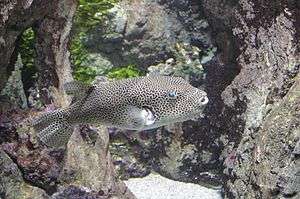
Understand
Guarding the entrance to the Kanmon Straits that separate Honshu from Kyushu, the strategically located "Lower Barrier" played a role in three battles that triggered major changes in Japanese history. In 1185, the Battle of Dan-no-ura took place in the Straits, ending in a decisive victory for the Minamoto clan; the victory brought the Genpei War to a close, and with it the classical Heian period of Japanese culture. Shortly afterward, a new shogunate was established in Kamakura.
In 1863, another battle thrust Shimonoseki onto the world stage. Fueled by disgust with the terms of the treaty that opened Japanese ports to Western nations, warriors of the Choshu domain rebelled, expelling foreigners and blocking the passage of trade ships through the Kanmon Straits. The Bombardment of Shimonoseki continued for more than a year, until a fleet of warships from England, the Netherlands, France, and the United States (in the midst of its own civil war) forced the Choshu-han to surrender. Their open defiance served to undermine the Tokugawa shogunate, however, which fell only three years later.
Although the fighting took place elsewhere, the treaty that ended the First Sino-Japanese War in 1895 was signed in Shimonoseki, marking a stage in the ascent of the newly-modernized Japanese Navy — and the nation as a major regional military power.
Today, Shimonoseki has a busy international port, with frequent traffic from China and South Korea, among others. It faces Kitakyushu across the Kanmon Straits, forming one of the world's busiest lanes of maritime shipping.
| Shimonoseki | ||||||||||||||||||||||||||||||||||||||||||||||||||||||||||||
|---|---|---|---|---|---|---|---|---|---|---|---|---|---|---|---|---|---|---|---|---|---|---|---|---|---|---|---|---|---|---|---|---|---|---|---|---|---|---|---|---|---|---|---|---|---|---|---|---|---|---|---|---|---|---|---|---|---|---|---|---|
| Climate chart (explanation) | ||||||||||||||||||||||||||||||||||||||||||||||||||||||||||||
| ||||||||||||||||||||||||||||||||||||||||||||||||||||||||||||
| ||||||||||||||||||||||||||||||||||||||||||||||||||||||||||||
Tourist information
Tourist information is available at JR Shimonoseki Station and JR Shin-Shimonoseki Station.
- 🌍 Shimonoseki Tourist Information Center (下関観光情報センター, Former Akita Company Building), 23-11 Nabe-cho, ☎ +81 83-231-4141. 9:30AM-5PM.
Get in
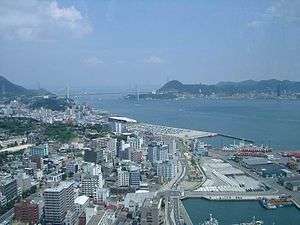
By train
- 🌍 JR Shimonoseki Station (下関駅), Takezakichō 4-3, ☎ +81 83-232-8383. 9AM-7PM. The next-to-last stop on the San'yo Main Line and the last stop on the San'in Main Line.
- 🌍 JR Shin-Shimonoseki Station (新下関駅) (Seven minutes away from JR Shimonoseki Station by local trains and buses.), ☎ +81 83-256-3422. 9AM-7PM. The local shinakansen stop. Only the all-stops Kodama trains stop at Shin-Shimonoseki, along with three daily Hikari trains in each direction (toward Hakata in the morning, from Hakata in the evening).
If you're coming from a long distance, the best option is to take a Nozomi or Hikari train to Kokura on Kyushu, and then backtrack on the San'yo Main Line via Moji Station in Kitakyushu. By this route, Shimonoseki can be reached by Nozomi in about 5 1/2 hours from Tokyo and 2 1/2 hours from Osaka.
By bus
The Dream Fukufuku bus runs overnight from Tokyo and Yokohama (15 1/2 hours, ¥13000). Another Fukufuku departs nightly from Osaka Umeda (10 hours, ¥9150).
By ferry
- 🌍 Shimonoseki Port (下関市港湾局), Higashiyamatomachi 1-10-50 (A short walk from JR Shimonoseki Station.), ☎ +81 83-231-1390. There are high-speed ferries throughout the day from Moji Port in Kitakyushu.
Daily ferries run by Kampu Ferry (tel. +81 83-224-3000) connect to Busan in South Korea. Ferries leave Busan at 8PM and arrive in Shimonoseki at 8AM the next morning, and leave Shimonoseki at 7PM for an 8:30AM arrival in Busan (8AM on Monday). 2nd class one-way tickets cost ¥9000, making this the cheapest way to get from Japan to another country. Arrive a few hours early for visa inspection, though!
There are also twice-weekly ferries from Suzhou, China on Shanghai Shimonoseki Ferry (leaves Suzho Tu, arrives Th). A 2nd class one-way ticket costs ¥15,000.
By car
For those travelling the expressways and only wanting a bit of fugu, even the Nexco Parking Areas either side of the Kanmon Bridge offer it in a variety of pre-prepared forms including frozen sashimi omiyage platters. The views are rather nice too making it a worthwhile break regardless.
For those travelling by way of thumb, note the aforementioned parking areas are easily accessible on foot and frequented almost as much as the standard Service Area. The Kyushu side stop services northbound traffic and the Honshu southbound.
Get around
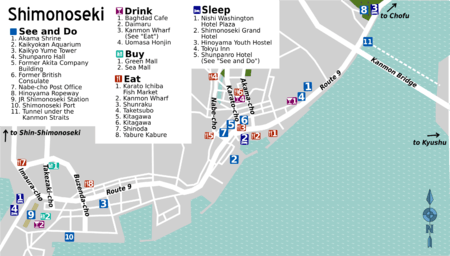
By bus
City buses are run by Sanden Kotsu, with stops that include both major train stations and the tourist attractions in the port and Chofu areas. When you board, take a ticket from the dispenser; when the bus reaches your destination, compare the number on your ticket to the numbers at the front of the bus, and that will tell you how much to pay. Short trips cost ¥170.
Shimonoseki was given one of London's distinctive red double-decker buses as that city phased them out. It now runs along the coast on weekends.
On foot
Almost all of the attractions are reachable on foot along Route 9, which runs parallel to the coastline. The Chofu area is a much longer walk, though.
See
Port area
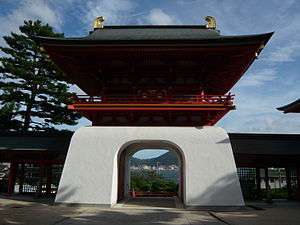
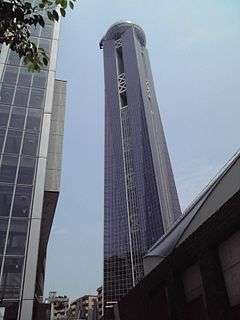
- 🌍 Akama Jingū (赤間神宮), 4-1 Amidaiji-cho (Bus to Akama-jingu-mae). 9AM-5PM. A shrine dedicated to the loser of the Battle of Dan-no-ura, Emperor Antoku of the Heike Clan, whose tomb is on the premises. Aside from the impressive vermilion gate, look for Hoichi Hall and the statue of Mimi nashi Hoichi (Earless Hoichi), who features in a well-known ghost story by Lafcadio Hearn. Free.
- 🌍 Ganryūjima (巌流島) (off the southern coast). This tiny island was the site of an epic samurai duel between Miyamoto Musashi and Sasaki Kojirō, two master swordsmen. Kankō Kisen runs ferries from Karato Pier (ten minutes, ¥1000 round-trip).
- 🌍 Hinoyama (火の山). At 268 meters high, Hinoyama offers good views of the Kanmon Straits. There's a ropeway to the peak if you'd prefer not to hike (¥200/400 one-way/return), and a pleasant park at the top. And since there's not enough of them in the city below, you'll find a fugu restaurant (11AM-9PM) and souvenir shop (9AM-6PM) as well. Buses run from JR Shimonoseki Station.
- 🌍 Kaikyokan Aquarium, 6-1 Arcaport, ☎ +81 83-228-1100. 9:30AM-5:30PM. Dolphins, penguins, and sea lions join over 100 varieties of pufferfish, with four floors of exhibits about marine science and shows throughout the day. It's right next to the Kanmon Bridge, and buses run directly there. ¥1800 adults, ¥900 children.
- 🌍 Kaikyō Yume Tower (海峡ゆめタワー), 3-3-1 Buzenda-cho, ☎ +81 83-231-5600. 9:30AM-9:30PM. Standing 153 meters tall, the Kaikyou Yume Tower features an observation deck in the glass sphere at the top, with panoramic views over the city and the Kanmon Straits. Internet access is available at the Yamaguchi International Exchange Association (Tu-Su 10AM-8PM). Observation deck ¥600 adults, ¥300 children.
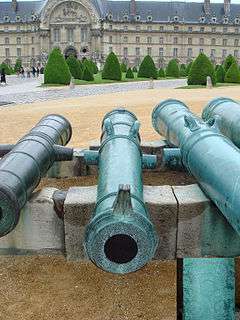
- Near the Kanmon Bridge, there is a marker for the site of the Battle of Dan-no-ura. The Bombardment of Shimonoseki is also commemorated nearby — there are a few replica cannons, positioned at the point where the allied troops came ashore. Now perfectly willing to do trade with foreign barbarians, the cannons will puff out a bit of smoke and a 'boom' in exchange for a few coins.
- 🌍 Shunpanrō Hall (春帆楼), Amidaijichō 4-2, ☎ +81 83-223-7181. The Treaty of Shimonoseki, which ended the First Sino-Japanese War, was signed on this site in 1895. There is a small museum (built in 1936) dedicated to the treaty with period furniture and some relics. It's next to an expensive ryokan (see Sleep). Free.
- 🌍 Sumiyoshi-jinja (住吉神社), 1-11-1 Ichinomiyazumi-kichi, ☎ +81 83-256-2656. A complex of shrines dedicated to the Shinto gods of the sea and sailing, with a main hall that has been designated a national treasure. There are displays of ancient scrolls, metalworks, and other relics. It's about a 20 minute walk from Shin-Shimonoseki Station, and can be reached from the Ichinomiya bus stop.
Karato area
Meiji-era foreign buildings mixed with modern ferroconcrete in the Karato area, which are illuminated at night.
- 🌍 Former Akita Company Building (旧秋田商会ビル Akita Shokai), 23-11 Nabe-cho, ☎ +81 83-231-4141. 9:30AM-5PM. This European-style building originally housed the offices of a shipping company. There's a particularly nice Japanese garden on the roof; the first floor has sightseeing information and a gift shop.
- 🌍 Former British Consulate (旧下関英国領事館), Karatochō 4-11, ☎ +81 83-235-1906. Tu-Su 9AM-5PM. Built in 1906, with the small Shimonoseki Ijinkan Museum inside and a tea house in the back.
- 🌍 Nabe-cho Post Office (下関南部町郵便局), 22-8 Nabe-cho, ☎ +81 83-222-0161. Built in 1900, this is the oldest post office still in service in Japan.
Chofu area
The Mori clan lived in this well-preserved castle town and samurai quarter in the northeastern part of the city, which makes a nice, atmospheric walk at any hour. Buses run to stops for Matsubara and Joka-machi (25 minutes, ¥340). There is a Chōfu station on the San'yo Main Line, but it's a bit of a walk from there to the attractions.
- 🌍 Chofu Garden (長府庭園). 9AM-5PM. An elegant Japanese garden built for a chief retainer of the Mori clan, encircled from the outside world by trees and a small mountain. ¥200.
- 🌍 Chōfu Mōri Residence (長府毛利邸, chōfu mōri yashiki). 9AM-5PM. Built in 1903 by the ruling Mori family, this palatial estate and its gardens were deemed worthy of a visit by the Emperor Meiji a few years later. ¥200.
- 🌍 Iminomiya-jinja (忌宮神社). This modest temple comes alive between August 7-13, when a festival is held in honor of the Emperor Chūai and Empress Jingū — particularly wild at night. Free.
- 🌍 Kōzan-ji (功山寺), 1 Kawabuchi, ☎ +81 83-245-0258. 9:30AM-4:30PM. Although it is Japan's oldest zen temple (and a national treasure), founded in 1327, Kozan-ji has been known through the years as a place for warriors to rouse themselves before battle. The Chofu Museum (Tu-Su 9AM-5PM, ¥200) is on the grounds of the temple, with displays about the Meiji Restoration. Free.
- 🌍 Nogi-jinja (乃木神社). A shrine dedicated to General Nogi Maresuke, a key leader in the First Sino-Japanese War and the Russo-Japanese War. Ashamed by the number of lives lost under his command in the latter, Nogi petitioned the Emperor Meiji for permission to commit seppuku. His petition was denied; the Emperor told Nogi that "if you insist on killing yourself, let it be after I have departed from the world." When the Emperor did depart, seven years later, Nogi was still ready; he committed seppuku shortly after the Emperor's funeral entourage left the palace. As a result, Nogi came to be seen as a symbol of the end of the samurai code.
- 🌍 Shimonoseki City Art Museum (下関市立美術館), 1-1 Kuromon Higashi-machi, ☎ +81 83-245-4131. Tu-Su 9:30AM-4:30PM. Mostly exhibits of work (paintings and other media) by contemporary Japanese artists, but there are some traveling Western exhibitions and displays of Asian relics as well. ¥200.
- 🌍 Shimonoseki Municipal Archaeological Museum (下関市立考古博物館), 454 Ayaragioka (JR Ayaragi Station), ☎ +81 83-254-3061. Tu-Su 9:30AM-5PM. Displays of Kofun and Yayoi-era archaeological finds (as far back as 500 B.C.), including a few outdoor mounds, pit dwellings, and tombs. Free.
Do
- Although the Fukuoka Daiei Hawks and the Hiroshima Toyo Carp are geographically closer, many local baseball fans retain a loyalty to the Yokohama BayStars, which began in 1950 as the Shimonoseki-based Taiyo Whales. If you want to impress a native, pick up a blue and white BayStars jersey with "birthplace of the team: Shimonoseki" in Japanese (球団発祥の地 下関) on the back.
- Leaving already? A pedestrian tunnel allows visitors to walk the Kanmon Straits to Moji in about fifteen minutes, with about 780 meters of the walk under the sea. Access to the tunnel is free, 6AM-10PM.
- There are several hot spring resorts in town, but most are well off the tourist track, and will require a car or a long taxi ride.
Festivals
- Kanmon Straits Fireworks Festival (関門海峡花火大会, kanmon kaikyō hanabi taikai). One of Japan's largest fireworks festivals is held over the Kanmon Straits every year on August 13th, with over a million people in attendance and 13,000 hanabi to enjoy.
- Kaikyo Festival (海峡まつり, kaikyō matsuri) (held mostly in the Karato area or Ganryujima). Annually on May 3rd. With re-enactments of naval battles and other historical intrigues.
- Bakan Festival (馬関まつり, bakan matsuri). The Bakan Festival takes over the city in the last weekend of August, with food and night markets lining the streets between JR Shimonoseki Station and the Karato area, culminating in a group dance.
- The Little Busan Fest celebrates Shimonoseki's Korean culture every November at the Green Mall.
Buy
If you'd like a plush, adorable poisonous fish to bring home, visit the Fukufuku World on the fourth floor of the Kaikyo Yume Tower (see above) for the full line of fugu character goods.
- 🌍 Green Mall (グリーンモール), 2-chome Takezaki-cho. Because of the many Korean shops and BBQ restaurants gathered here, this stretch of Takezaki-cho and its side streets are often called "Little Busan" or simply "Koreatown". Many stores will even accept South Korean currency.
- 🌍 Sea Mall (シーモール), 4-4-8 Takezaki-cho, ☎ +81 83-232-1118. Hours vary by store. One of the biggest shopping centers in western Japan, with 170 stores including Best Denki and DeoDeo (electronics), Daimaru (department store), and Daiso (¥100 knick-knacks), as well as loads of restaurants.
Eat
|
Two fugu fans The Japanese poet Yosa Buson (1716-1783) wrote a famous senryū about forbidden love and the forbidden fish: |
Even if you don't usually eat seafood, you may want to make an exception for Shimonoseki's most famous dish: fugu (ふぐ) (pronounced "fuku" locally). While the flesh and skin are often completely harmless, the internal organs of some species of pufferfish pack enough lethal toxins to paralyze every muscle in the human body. "Fugu" is a generic term that covers many types of pufferfish; Torafugu (Tiger puffer), arguably the most popular type, has extraordinarily poisonous livers, ovaries, and intestines that must be carefully removed before preparation.
In order to serve fugu, chefs must be specially licensed, which entails several years of apprenticeship and a rigorous exam that sees a 70% failure rate. These steps ensure that fugu fatalities at restaurants are virtually unheard of. The city maintains a list of restaurants licensed to serve it .
The most popular form is fugu sashimi, thinly sliced. But it can also be served as part of a salad (yubiki), a stew (fugu-chiri), fried with hot sake (fugu hire-zake), or deep fried (fugu-kara-age). Most restaurants serving the dish will be pricey, but set meals with a bit of fugu can be had near the Kanmon Wharf or Karato Pier for ¥1100 or so.
Some people are underwhelmed by the taste of fugu — the flavor is more subtle than that of more oily fish like maguro (tuna), but it has a distinctive taste that keeps aficionados coming back for more than just thrills. A few diners report their lips, tongues, or even fingertips tingling while eating fugu (a condition referred to as shibireru), supposedly the result of chefs leaving trace amounts of the toxin on the fish. But given the legal ramifications of an even accidental poisoning, many dismiss the sensation as urban legend, all in the diners' imagination.
The other infamous local specialty is whale (鯨 kujira), which tastes like fishy steak and is served both raw and cooked. Shimonoseki has been the base for some of Japan's controversial whaling expeditions.
Budget
There are cheap food courts with the likes of Kentucky Fried Chicken and Mr Donut on the fourth floor of Sea Mall (10AM-10PM) and the seventh floor of Daimaru (11AM-9PM). For Korean BBQ, check the Green Mall area.
- 🌍 Karato Ichiba Fish Market (唐戸市場), 5-50 Karato-machi, ☎ +81 83-231-0001. 4AM-12PM or so. Tons of fresh seafood — not only fugu. There are some fabulous sushi bars upstairs and a lawn on the roof to relax on. Get there early in the morning for the best selection of sushi/sashimi on the market floor — buses run from JR Shimonoseki Station beginning at 5:55AM weekdays. Entrance is free; most fish will cost between ¥100-500.
Mid-range
- 🌍 Kamon Wharf (カモンワーフ), 6-1 Karato-machi, ☎ +81 83-228-0330. Most restaurants 11AM-10PM. There are almost two dozen restaurants and cafes on the first and second floors, with plenty of crab, sushi, and (of course) fugu, but also Korean food and okonomiyaki as well. Prices vary by restaurant.
- 🌍 Shunraku (旬楽館), 3-10 Karato-cho, ☎ +81 83-228-2452. 11AM-3PM, 5PM-10PM. Among the more affordable places for sit-down fugu, with nice mini-sets from ¥3800, and plenty of udon, tempura, and sushi dishes in the ¥2000 range for your friend who thinks you're nuts for wanting to eat a poisonous fish.
- 🌍 Taketsubo (竹つぼ), 3-3-6 Naka Ueda-cho (Mizukami Building, 1st floor), ☎ +81 120-32-9432. 5:30PM-10PM. This small, personable restaurant provides a kettle per table and invites diners to fry some tempura, with various spices on the side for dipping. The owner is a trained sommelier and will be keen to recommend a bottle of wine. Dinner from ¥4000 and up.
Splurge
- 🌍 Kitagawa (ふく処 喜多川). 11AM-9PM. A popular fugu restaurant (since 1871) with locations in the Karato area (7-11 Nabe-cho, +81 83-232-3212) and a bit northeast, off Route 57 (4-9 Akama-cho, +81 83-232-3211). Lunch from ¥3150, dinner ¥5250.
- 🌍 Shinoda (料亭しのだ), 7-9 Imaura-cho, ☎ +81 83-222-5267. 12PM-10PM. Locally-grown fruits and vegetables surround your fugu. The fugu mini kaiseki includes a pretty good amount of food for ¥5000, but if money is not an issue, deluxe sets run as high as ¥28,500.
- 🌍 Yabure Kabure (やぶれかぶれ), 2-2-5 Maeda Yutaka-cho, ☎ +81 83-234-3711. 11AM-3PM, 5PM-10PM. Fugu in the boozing district — look for the big blue & white fugu head out front. Lunch sets from ¥3100; dinner ¥5250-12,600.
- The restaurants for Shimonoseki Marine Hotel and Shunpanro (see Sleep) are also acclaimed for their fugu.
Drink
Buzenda-cho (豊前田町) is the local red-light district, packed with karaoke boxes, hostess bars, and restaurants, a short walk east of JR Shimonoseki Station. Bars are also clustered on Hisashi-guchi, near Green Mall.
- 🌍 Daimaru (下関大丸), 4-4-10 Takezaki-cho, ☎ +81 83-232-1111. Aside from the many restaurants clustered herein, there's a Starbucks (8AM-9PM Su-Th, to 10PM F-Sa) for coffee hounds and a beer garden on the 8th floor rooftop garden (late May to early September, 5:30PM-9PM) with bar food and all-you-can-drink for ¥3300.
- 🌍 Uomasa Honjin (魚正本陣), 4-20 Akama-cho, ☎ +81 83-234-0732. 5PM-11PM. While you're drinking, order a la carte from their menu of sashimi (including fugu and whale), nabe, and various fried items. And if you'd like to mix your poisons, ask for the fugu fin sake.
Sleep
There are more plentiful accommodations over the water in Fukuoka.
Budget
- 🌍 Hinoyama Youth Hostel (火の山ユースホステル), 3-47 Mimosusogawa-cho, ☎ +81 83-222-3753. Dorm rooms with tatami floors, a washer & dryer, and free Internet access. By bus, exit at the Mimosusogawa stop (after passing the Kanmon Bridge) and head uphill. Beds ¥3200, breakfast ¥630.
- 🌍 Nishi Washington Hotel Plaza (下関駅西ワシントンホテルプラザ), 1-4-1 Yamato-cho, ☎ +81 83-261-0410. Clean, Western-style rooms in a business hotel outside the west exit of the station, with Internet access and a shabu shabu restaurant on the premises. Rooms from ¥5800 single, ¥14,000 twin.
- 🌍 Via Inn (ヴィアイン下関), 4-2-33 Takezaki-cho, ☎ +81 83-222-6111. A decent business hotel with small, pleasant rooms and Internet access, outside the east exit of the station. Rooms from ¥5775 single, ¥10,800 double.
Mid-range
- 🌍 Shimonoseki Grand Hotel (下関グランドホテル), 31-2 Nabe-cho, ☎ +81 83-231-5000. A luxury hotel in the Karato area. Most rooms have balconies, and there's a beer garden on the roof. Western-style rooms from ¥9240 single and ¥16,170 double; Japanese-style suites from ¥36,960. City views are about ¥1000 cheaper than sea views.
- 🌍 Smile Hotel (スマイルホテル), 4-4-1 Takezaki-cho, ☎ +81 83-233-0111. Nine floors of standard-issue Western-style rooms. Rooms from ¥5000 single, ¥6,000 double.
Splurge
- 🌍 Shunpanro Hotel (割烹旅館春帆楼), Amidaijichō 4-2, ☎ +81 83-223-7181. Aside from the historic significance described above, the restaurant of this luxury ryokan was also the first licensed to serve fugu after the ban was lifted. Luxury accommodations with dinner as low as ¥21,000, though usually higher; however, it will still considerably less than what the Chinese paid for their visit.
Go next
- Kitakyushu on Kyushu is a short train ride from Shimonoseki. It's also reachable via ferry and bridge. There is a tunnel for walkers at the narrowest point across the Kanmon Straits.
- Hagi is one of the most beautiful castle towns in Japan.
- Yamaguchi city is the prefectural capital.
| Routes through Shimonoseki |
| Hakata ← Kokura ← | W |
→ Asa → Yamaguchi → Hiroshima |
| W |
→ Hagi → Matsue | |
| W |
→ Ube → Hiroshima | |
| W |
→ Mine → Hiroshima | |
| END ← | W |
→ Onoda → Hiroshima |